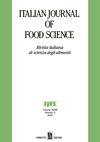家庭主要烹饪系统对环境的影响——一项调查
IF 3.3
4区 农林科学
Q2 FOOD SCIENCE & TECHNOLOGY
引用次数: 7
摘要
食物烹饪能量可能代表几种食物和饮料从摇篮到坟墓生命周期中的主要热点。它主要受食物类型及其烹饪方法、烹饪器具和选择的燃料以及烹饪份数的影响。这项调查的主要目的是展示主要烹饪方法、器具和燃料的基本特征,以及一些关键食品所需的能源。第二个目的是通过使用ReCiPe 2016和产品环境足迹(PEF)标准方法以及Ecoinvent v.3.7数据库,评估在意大利情景中,通用烹饪系统作为使用不同燃料(即木柴、木炭、煤炭、天然气、液化石油气、煤油和沼气)和电力的少数家用炊具的功能对环境的影响。2019年,27个欧盟国家将相当于人均烹饪有用能量(1.41千兆焦耳[GJ])的功能单位用作比较基础。在ReCiPe 2016方法的18个中点影响类别中,天然气的使用导致9个影响最小,两个损害类别(人类健康和生态系统质量)的最小总加权损害评分(OWDSR)为~5Pt。因此,这种炉灶似乎更容易将室内外空气污染降至最低。即使电动炉灶的OWDSR更高(8.6 Pt),因为意大利的电网结构主要基于化石能源,也可以预测,由水力和风能驱动的新一代智能炉灶将使OWDSR分别降至0.9和1.4 Pt,从而不仅避免了任何化石能源的消耗,而且改善了人们的健康。本文章由计算机程序翻译,如有差异,请以英文原文为准。
Environmental impact of the main household cooking systems—A survey
The food cooking energy may represent the primary hotspot in the cradle-to-grave life cycle of several foods and drinks. It is mainly affected by the type of food and its cookery method, cooking appliance and the fuel selected as well as the number of portions to be cooked. The primary aim of this survey was to demonstrate the basic characteristics of the main cooking methods, appliances, and fuels as well as energy required for some key foods. The secondary aim was to assess the environmental impacts of a generic cooking system as a function of few household cookers fueled by different fuels (i.e., firewood, charcoal, coal, natural gas, liquefied petroleum gas, kerosene and biogas) and electricity in the Italian scenario by using the ReCiPe 2016 and product environmental footprint (PEF) standard methods and Ecoinvent v. 3.7 database. A functional unit equal to per capita useful energy delivered to the pot for cooking (1.41 gigajoule [GJ]) in 27 European Union countries in 2019 was used as the basis of comparison. The use of natural gas resulted in minimum impact in nine of the 18 mid-point impact categories of ReCiPe 2016 method and two damage categories (human health and ecosystem quality) with a minimum overall weighted damage score (OWDSR) of ~5 Pt. Thus, such a cookstove appeared to be more apt to minimize both indoor and outdoor air pollution. Even if the electric cookstove yielded a greater OWDSR (8.6 Pt) because the Italian electricity grid mix was mainly based on fossil sources, it was possible to forecast that new-generation, smart cooktops driven by hydro- and wind-power electricity would minimize OWDSR to as low as 0.9 and 1.4 Pt, respectively, thus not only avoiding the consumption of any fossil energy source but also improving people’s health.
求助全文
通过发布文献求助,成功后即可免费获取论文全文。
去求助
来源期刊

Italian Journal of Food Science
工程技术-食品科技
CiteScore
4.20
自引率
0.00%
发文量
33
审稿时长
>36 weeks
期刊介绍:
"Italian Journal of Food Science" is an international journal publishing original, basic and applied papers, reviews, short communications, surveys and opinions on food science and technology with specific reference to the Mediterranean Region. Its expanded scope includes food production, food engineering, food management, food quality, shelf-life, consumer acceptance of foodstuffs, food safety and nutrition, energy and environmental aspects of food processing on the whole life cycle.
Reviews and surveys on specific topics relevant to the advance of the Mediterranean food industry are particularly welcome.
 求助内容:
求助内容: 应助结果提醒方式:
应助结果提醒方式:


